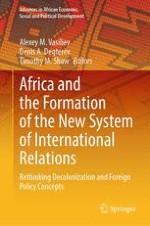2021 | OriginalPaper | Buchkapitel
6. Designs of the Four: Comparing African Strategies of Russia, China, US, and EU Against the Backdrop of the (Re)emerging Bipolarity
verfasst von : L. L. Fituni
Erschienen in: Africa and the Formation of the New System of International Relations
Verlag: Springer International Publishing
Aktivieren Sie unsere intelligente Suche, um passende Fachinhalte oder Patente zu finden.
Wählen Sie Textabschnitte aus um mit Künstlicher Intelligenz passenden Patente zu finden. powered by
Markieren Sie Textabschnitte, um KI-gestützt weitere passende Inhalte zu finden. powered by
